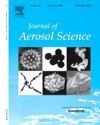Dispersion of particles and airflow optimization for a semiconductor cleanroom
IF 3.9
3区 环境科学与生态学
Q2 ENGINEERING, CHEMICAL
引用次数: 0
Abstract
Electronic cleanrooms' airflow and particle behavior significantly impact product quality and energy consumption. The airflow and particle diffusion at different supply air velocities are calculated for a semiconductor cleanroom, well-validated against established data. An RNG k-ε model and discrete phase model (DPM) are employed to simulate airflow and particle transport. Transient distributions, residual counts, and removal times are compared for six air supply velocities ranging from 0.2 m/s to 0.12 m/s. The results indicate that vortices are easily generated in the corners formed by the walls and the ceiling edge. The local vortices result in a longer particle removal time. Under stable conditions, all particles released from the ceiling, walls 1, 2, 4, and the raised floor are removed from the cleanroom across six supply air velocities. Two particles released from wall 3 remain as residuals when the supply air velocity is reduced. The final residual particles are primarily located near equipment 6. When the supply air velocity decreases from 0.22 m/s to 0.16 m/s, the stable time remains at 14 min. However, it increases significantly to 17 min and 23 min at 0.14 m/s and 0.12 m/s, respectively. The addition of two Fan Filter Units (FFUs) in the corners of the ceiling enhances both airflow and particle diffusion, reducing removal times by 2–7 min across different air speeds. These results provide theoretical guidance for selecting supply air velocity and optimized the arrangement of FFUs and equipment.
半导体洁净室的粒子分散和气流优化
电子洁净室的气流和颗粒行为对产品质量和能耗有显著影响。对半导体洁净室在不同送风速度下的气流和粒子扩散进行了计算,并根据已建立的数据进行了验证。采用RNG k-ε模型和离散相模型(DPM)模拟气流和颗粒输运。瞬态分布,残余计数和去除时间进行了比较,六个空气供应速度范围从0.2米/秒到0.12米/秒。结果表明:在墙体和顶棚边缘形成的拐角处容易产生涡流;局部涡旋导致粒子去除时间变长。在稳定的条件下,从天花板、墙壁1、2、4和活动地板释放的所有颗粒通过六个送风速度从洁净室中移除。当送风速度降低时,从第3壁释放的两个颗粒作为残留物存在。最终的残余颗粒主要位于设备6附近。当送风速度从0.22 m/s降低到0.16 m/s时,稳定时间保持在14 min,而在0.14 m/s和0.12 m/s时,稳定时间分别显著增加到17 min和23 min。在天花板的角落增加了两个风扇过滤单元(ffu),增强了气流和颗粒扩散,在不同的空气速度下减少了2-7分钟的去除时间。研究结果为选择送风速度、优化整流机组及设备布置提供了理论指导。
本文章由计算机程序翻译,如有差异,请以英文原文为准。
求助全文
约1分钟内获得全文
求助全文
来源期刊

Journal of Aerosol Science
环境科学-工程:化工
CiteScore
8.80
自引率
8.90%
发文量
127
审稿时长
35 days
期刊介绍:
Founded in 1970, the Journal of Aerosol Science considers itself the prime vehicle for the publication of original work as well as reviews related to fundamental and applied aerosol research, as well as aerosol instrumentation. Its content is directed at scientists working in engineering disciplines, as well as physics, chemistry, and environmental sciences.
The editors welcome submissions of papers describing recent experimental, numerical, and theoretical research related to the following topics:
1. Fundamental Aerosol Science.
2. Applied Aerosol Science.
3. Instrumentation & Measurement Methods.
 求助内容:
求助内容: 应助结果提醒方式:
应助结果提醒方式:


